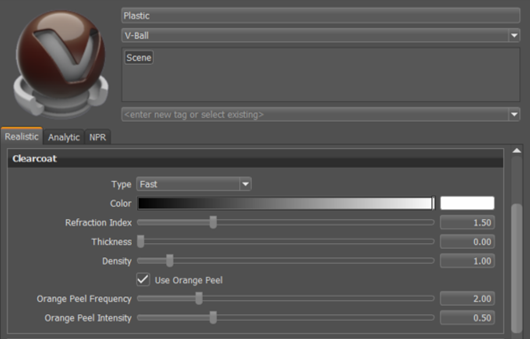Clearcoat (2023.1)
Added a Clearcoat section containing options for setting clearcoat attributes to Plastic materials.

Now, you can add an additional clearcoat layer and adjust parameters like the thickness, color, and density of the clearcoat. With this new option, you can create, for example, a textured material with a layered clearcoat on top of it. And with the new decoupled Material Editor, you can also set a clearcoat for multiple Plastic materials at once.
- Type - Defines the intensity of a reflection, based on the viewing angle. Its intensity at normal incidence is set by the material's reflectivity. Choose from the following:
Off - Turns off the clearcoat.
Fast - Uses a fast, but less accurate, approximation to the Fresnel Term (Schlick approximation) to create the clearcoat layer.
Accurate - Uses a physically accurate evaluation of the Fresnel Term (Cook-Torrance approximation) to create the clearcoat layer.
- Color - Sets the pigment color in the layer.
- Refraction Index - Sets the material's refraction index. The index of refraction allows glass-on-glass contact situations. It shows the amount the rays are reflected off the surface versus absorbed (refracted into the surface).
- Thickness - Sets the thickness of the clearcoat.
- Density - Determines the concentration of particles in the clearcoat, which affects the color of the clearcoat. Use this in combination with Thickness and a non-white color, as white is completely transparent.
- Use Orange Peel - Applies a bump structure to the layer. Use the following options to customize this:
Orange Peel Frequency - Sets the bump structure's noise frequency. The higher the value, the closer together the orange peel bumps.
Orange Peel Intensity - Sets the bump structure's intensity. The higher the value, the more visible the orange peel and less smooth the clearcoat surface.